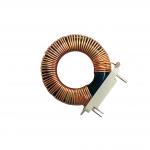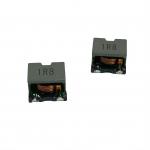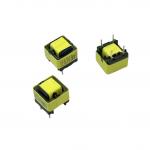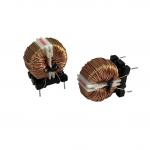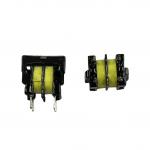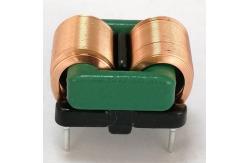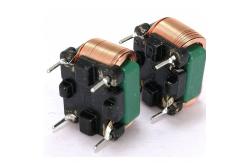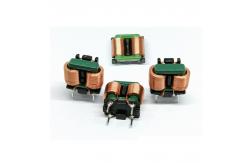High Power Flat Wire Common Mode Inductor Plug-In Inductance
Horizontal1.Product DescriptionHorizontal common mode inductor filter is a key component commonly
used in electronic circuits to suppress electromagnetic
interference. It adopts a horizontal structure design, which is
easy to install on a printed circuit board (PCB) and can
effectively save space, especially suitable for electronic products
with high spatial layout requirements. Its working principle is
based on electromagnetic induction. By winding two sets of
symmetrical coils around the magnetic core, when a common mode
interference signal passes through, the induced electromotive force
generated by the two sets of coils is in the same direction,
resulting in high impedance and suppression of the common mode
signal; For normal differential mode signals, the induced
electromotive forces generated by the two coils cancel each other
out, with minimal impact on the differential mode signal.
Horizontal common mode inductive filters are widely used in various
electronic devices, such as computers, communication equipment,
etc., which can effectively improve the electromagnetic
compatibility of equipment and ensure the stable and reliable
operation of electronic systems. 2.Features | Features | Descriptions | | Horizontal Design | - Space - saving: Occupies less vertical space on the printed
circuit board (PCB), enabling more compact PCB layouts. This is
highly beneficial for devices with limited internal space, such as
smartphones, tablets, and small - form - factor laptops. | | - Easy Installation: Facilitates straightforward mounting on the
PCB. The horizontal orientation allows for simple insertion into
pre - drilled holes or attachment using surface - mount technology,
reducing the complexity of the assembly process. | | Common - mode Noise Suppression | - High Impedance to Common - mode Signals: Effectively blocks
common - mode electromagnetic interference (EMI) by presenting a
high impedance to such signals. This is achieved through the design
of two symmetric windings on a magnetic core. When common - mode
currents flow, the magnetic fields generated by the two windings
add up, resulting in a significant impedance increase and thus
suppressing the common - mode noise. | | - Wide Frequency Range: Can suppress common - mode noise over a
broad frequency spectrum, from low - frequency power - line
harmonics to high - frequency radio - frequency interference. This
makes it suitable for various applications, including power
supplies, data communication lines, and audio circuits. | | Low Impact on Differential - mode Signals | - Low Impedance to Differential - mode Signals: For differential -
mode signals, the magnetic fields generated by the two windings in
the inductor cancel each other out. As a result, the inductor
presents a relatively low impedance to differential - mode signals,
allowing them to pass through with minimal attenuation. This
ensures that the normal operation of the circuit, which relies on
differential - mode signals for data transfer or signal processing,
is not disrupted. | | Magnetic Core Properties | - High Magnetic Permeability: The magnetic core used in the
inductor typically has a high magnetic permeability. This property
helps to concentrate the magnetic field, enhancing the inductor's
ability to couple magnetic flux and thus improving its
effectiveness in suppressing common - mode noise. | | - Low Core Loss: Minimizes energy losses in the magnetic core,
reducing heat generation. This is crucial for maintaining the
efficiency of the circuit, especially in applications where the
inductor is required to handle high - current or high - frequency
signals for extended periods. | | Robust Construction | - Mechanical Stability: Built with a sturdy structure to withstand
mechanical stresses during the manufacturing process, as well as in
the end - use environment. This includes resistance to vibrations,
shocks, and temperature variations, ensuring reliable performance
over the product's lifespan. | | - Good Insulation: The windings and the magnetic core are well -
insulated to prevent electrical short - circuits and to ensure
electrical safety. The insulation materials also contribute to the
inductor's ability to operate in different environmental
conditions, such as high humidity or dusty environments. |
|
